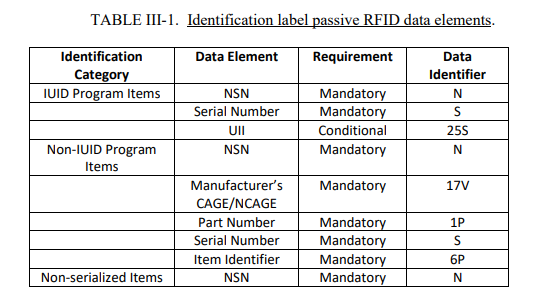Keeping up with Department of Defense standards of practice for military marking for shipment and storage is imperative to ensuring compliance. As of September 2019, the MIL-STD-129R Change 2 supersedes Change 1, released in 2018. Are you current with the most recent changes?
Of course, you could read through the entire 175-page report to make sense of it all yourself. To save you time, our military compliancy experts summarize the chief updates for you in this article.
First, let’s review the MIL-STD-129R packaging requirements. In 2007, mandatory 2D PDF417 barcodes required linear barcodes on outer containers. Seven years later, the MIL-STD-129R regulation added the TTN, or Transportation Tracking number, in addition to the PDF417 symbology on Intermediate and Unit labels. RFID use became the norm for pallet and case shipments, and ammo and explosives required HERO info (“hazards of electromagnetic radiation to ordnance” information).
The new 2019 MIL-STD-129R Change 2 for text marking for ammo and explosives must consist of both barcode and text marking to provide info regarding sourced material and storage processes to ensure accurate accounting of stock. Placement of the identification text for ammo and explosives, and address marking, also changed.
Change 2 of MIL-STD-129R specifies the accepted use of passive RFID technology, as detailed in the DoD Passive RFID Guide. RFID tech can now be used for storage purposes and item identification in addition to other MIL-STD-130 labeling requirements. Tags must be applied to palletized unit load and case shipments, while complying with EPC global Class 1, Generation 2 RFID tag rules. Data elements for IUID and non-IUID program items mandate including identifiers for non-serialized items (NSN) and serialized items. Non-IUID program items also must include data identifiers for the Manufacturer’s CAGE/NCAGE, part number, and item identifier. Learn more about RFID technology here.

Other changes in nomenclature include the addition of a new item identifier (concentrated CAGE/N/CAGE (manufacturer) + Part Number + Serial Number).
Changes in the unit pack and container identification in the 2D (PDF417) barcode format include:
• Sample data for Contract Number is displayed without special characters (-) (ANSI MH10.8.2 does not permit them.)
• Sample data for a part number is shown with a dash (-) to make the point that special characters (- or /) are permitted in part numbers.
• “The serial number component of a UII may or may not be the same as the item’s serial number.”
• A dash is incorporated in the “Serial Number or Code” sample data to make the point that special characters (- or /) are permitted in serial numbers
• A DI 6P “Item Identifier” includes plus (+) special characters, which ANSI MH10.8.2 does not authorize
• Three data elements are encoded with the PDF417 mark on unit packs and intermediate containers
In sum, Change 2 reflects numerous updates to MIL-STD-129. Most significantly:
• When a single 2D bar code cannot contain all item information, a set of Macro PDF417 barcodes can be used.
• DoD-originated shipments that are over-packed for fewer shipments are a marking exception.
• Specific instructions are detailed for palletized unit loads for bar code marking and identification.
• The TTN format is a conditional data element included when the system can encode and generate it.
• New alignment with DoD distribution definitions include replacing the phrase “direct vendor deliver (DVD)” with “customer direct”.
• The 2D PDF417 barcode is recommended on all package ID marking, and some are modified to remove the linear bar codes.
• The 2D PDF417 bar code content for container and unit pack marking is updated to include data info for the quantity and unit of issue (DI ‘7Q’) and for the part number (DI ‘IP’).
• Packing list requirements now fall into two categories: 1) a content packing list for contents that are contained within but not marked on the packaging; 2) a shipment packing list for multi-piece or single-piece shipments.
• The ammo and explosives section is completely overhauled to include new packaging label specifications.
And
• Numerous additional updates align with the DoD transitioning to life cycle management and are associated with IUID and serialized item management.
Change 2 to MIL-STD-129R contains a full plate of requirements to digest. Here’s our take: We find the additions of DI 6P as the most interesting changes in the new standards for compliance. We are doing additional analysis on DI 6P and future impacts to our customers. Please stay tuned or contact our ID Integration experts directly to discuss at 425-438-2533.
ID integration can help translate how these changes apply to your particular shipment marking processes. Whether you are brand new to MIL-STD-129R compliance, or whether you are a seasoned contractor with processes in place, our team is available to guide you in the right direction. Contact us to remain compliant without interruption.

